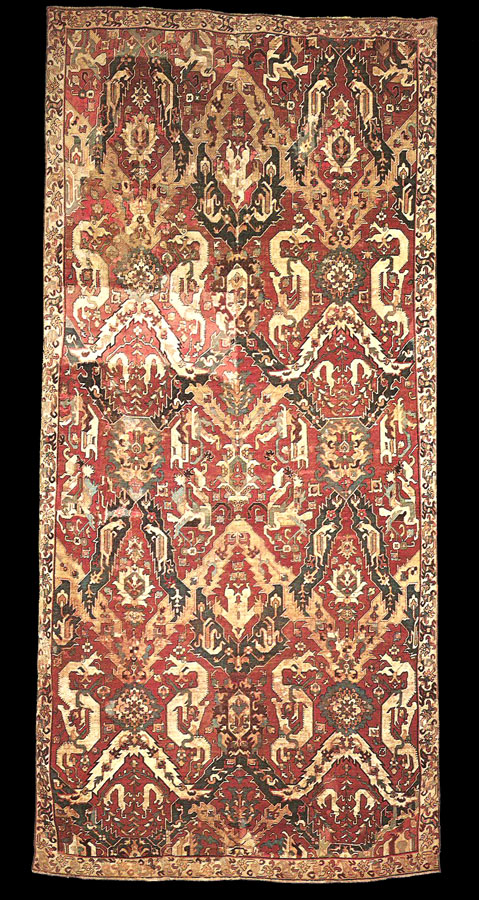Dragon Rug with Drop Repeat Design. Shirvan, Shemakha Area or Karabagh.
Mid or Late 17th Century. Textile Museum R 36.1.1 (formerly R 2.54).
A good, though faded example of the dragon rug's earliest and most
complete phase in which a drop repeat design translates the delicate vine
latticing of the Persian vase rug into the crude vernacular of the
Caucasus. Against a field color of soft, winy red is projected a double
network of jagged bands. One network is dark medium blue; the other a
light sand yellow except for the moustache-like pairs of "leaves"
immediately below the dragons, which are ivory, as are the dragons
themselves.
The field pattern opens with partial plaques and feather-like forms which
can be seen to be the backs and flames of magic lions, such as hover over
the chilin in the panel directly above the dragon. From that level the
pattern repeats, item for item, whatever it has displayed below. It is
worth noting that the dragon, the flaming lion, the chilin, together with
the mandarin duck and the golden pheasant, which appear, quite distorted,
on the dark blue leaflike portions of the band system, have been used as
symbols of rank in the Far East, which was also the source of the "chi" or
clenched fungoid forms which appear on the blue bands. The pairs of little
onagers or fawns in smaller panels are not Far Eastern, but come from the
Persian repertoire.
The tree palmette in the panel below the pheasants and the elaborate,
vertically aligned palmette where the blue bands cross are particularly
handsome. The figures along the center line were ruined by a tear down the
carpet's center, through which several inches of surface have been lost.
The dragons are among the best that can be found in the entire dragon rug
series.
The ivory border, a single stripe and narrow in the vase rug tradition,
shows a complex vine in varied colors. Simplified versions of this vine
appear in the later dragon rugs of Shusha and have continued in use in
semi-antique Karabagh and Karadagh runners.
Five other complete rugs of comparable pattern are known, aside from
fragments. The live include two which are almost a pair: one. formerly in
the Hanotaux Collection in Paris, now in the Siesta Collection, Milan, and
the other in the Great Mosque of Divrik in Anatolia. The third is in the
Burrell Collection in the Glasgow Museum, 9/38; the fourth in the Brooklyn
Museum, 58.130; the fifth, with a blue ground, was formerly at Stefan
Bardini's in Florence and reportedly went to America. A fragment from the
upper part of a carpet of this kind, in the Museum of Turkish and Islamic
Art in Istanbul, No. 204, offers panels of different colors, a well-known
vase rug tradition. It came from a mosque at Edirne. The lower part of
this carpet, filled out with new weaving, was in the Italian art market
some years ago and is said to be in a Swiss collection.
Size: L. 5.44 m. (17'10") x W. 2.39 m. (7'10").
Warp: Z2S, wool in a full range of natural shades, with some barber poles.
Alternate warps depressed.
Weft: Z2S wool in light natural mixtures, dyed a variable light red. Two
shots. At variable intervals single shot. (Z2S) 3S and (Z2S) 3Z, dyed
light or very pale red.
Pile: 2Z wool. Gordes knotted, pile slanting to left. 9 or 10 horiz. x 9
or 10 1/2 vert., per in. (81 to 95 per sq.in.)
Sides: Cut. Ends: Cut.
Colors: Ivory; black-brown; dull yellow-orange/tan; light sand yellow;
wine red; dark medium, light medium and light blues; light medium
blue-green, abrashed dark medium green; dark violet.
Condition: Cut down the center and rejoined, with some loss. Considerable
areas of reweaving in upper left quarter. End borders and parts of side
borders rewoven. The field may have been reduced somewhat at the top
Sundry patches and small repairs. Coloration duller and lighter than in
comparable carpets, perhaps due to fading.
Published; Aga-Oglu 1948: No. 4; Ellis 1970; Fig. 1.
|


